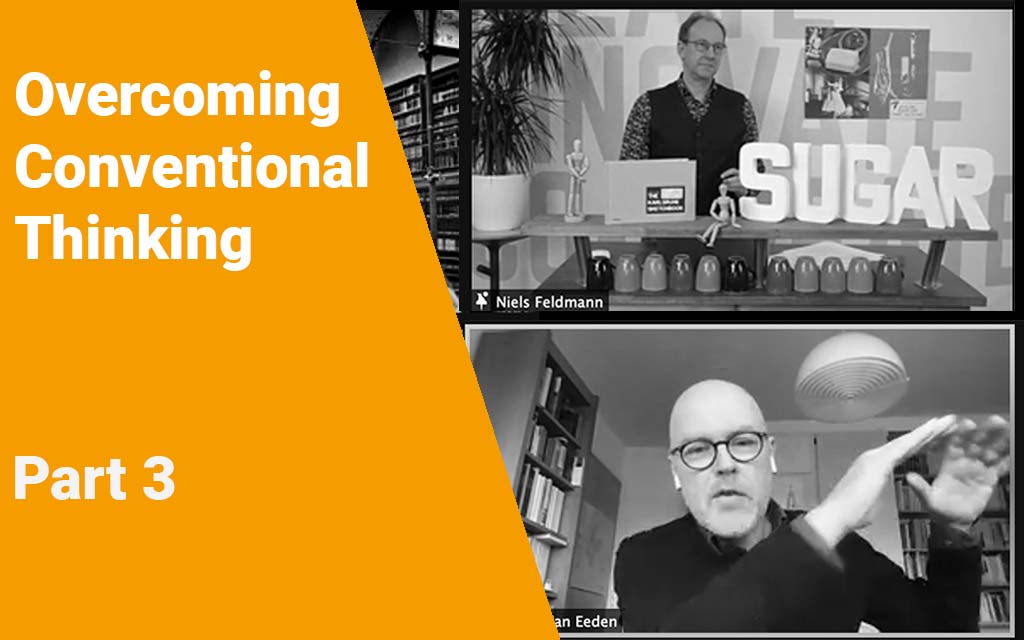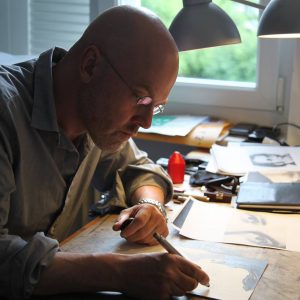Sources of Inspiration
Are there any further sources of inspiration for the artist Marcel van Eeden? Is there any approach to fall back to in case creativity does not flow as it should? These are the kind of questions we address in this part of our overcoming conventional thinking series (minutes 32:57 – 44:00 in the video).
Do artists create for a target group?
Audience: We come from the world of design which often is very user-centered. We have a target person for whom we want to design for and our process often starts with understanding this group of people to make something that ideally will be valuable for many of them. Do you also have a target audience in mind when creating?
MvE: Yeah, maybe I’m a very nice artist. I like the audience, as mentioned in the Fürth example. I like that people recognize something, i.e. their city or its history. So in these cases I’m doing it for people too. In the end it’s my own work. But for me, it’s okay if it’s Fürth or Stockholm. That makes no difference. So, it’s also the audience I have in mind but it’s more, it’s not the audience it’s not the content that I change for the audience, it’s just the form.
What to do if external impulses are missing?
RW: But on days where there isn’t an external trigger, how do you decide what your daily drawing is going to be?
MvE: The under stream is always my birth town, Den Hague. And there’s always a question from outside. So, I can always place stories related to this question in my native city and use images from there, e.g. from old streets and the like. Moreover, I can use experiences or visits I made. For instance, I was in Cambodia recently and was inspired to make something about Angkor Wat. Hence, I integrated it into a series about car racing.
RW: Is it also that sometimes doing one drawing triggers a completely different one? Like, ‘I’m now drawing this’ but that actually inspires me to draw something else because there are connections.
MvE: There is another track in my work: The idea is to create an encyclopedia of the time. I want to draw all the pictures that were there and then I make categories about everything like in an encyclopedia. For example, I was working on the category ‘fruit’, which is a lower category of food. And of course, there is meat and so forth. And then you make five or six drawings about fruits which are all different. There is one about fruit diseases, another one is just about fruits from a cookbook, or there can also be a very abstract one with cubistic fruit or something. There’s so much possible, it’s unbelievable.
RW: So, are your drawings for the next couple of months already penciled in? Or is it a new decision every morning?
MvE: Well, there is a list of things I want to work on. But it’s a new decision every morning. I’m now completely into etchings for a short time.
Do deadlines facilitate or hinder creativity?
CT: What do you do when creativity isn’t flowing the way you would like it to? How do you advise your students on that? Because sometimes there might be a deadline for an exhibition. How do you help that creative flow to flow in these situations?
MvE: There are some people who like deadlines and I’m one of them. For a moment, I get nervous or feeling a bit anxious when the deadline is approaching. But then things are coming. But other people could get completely blocked if there’s a deadline coming up and they get anxious about that. It’s different for everybody. Some people like to go to museums and see other shows to get inspired. I don’t like that, I don’t like to see art. I prefer walking or getting on a bike or something to gets my head free.
Is other art an inspiration?
RW: If you don’t mind, what books are in your library, if there aren’t art books?
MvE: I have always wanted to be a writer. So, I have more literature I think than art books. It may sound very stupid but in a museum I always have the problem, if you’re an artist yourself, when the art is better than your art you’re getting annoyed about this and you want to go home and make something better. Or it’s not good enough and you also get annoyed about it.
Recap & Take-Away
Where does inspiration for an artwork come from? This was the guiding question for part 3 of our conversation:
- [Take-Away] Know your innovation paradigm: For Marcel human-centricity as know from Design Thinking plays a subordinate role. His main objective is to visually convey a message, and not to provide a solution that is percieved useful by a large group of addressees. The two objective are not mutually exclusive but rather follow different paradigms.
- [Take-Away] Don’t let a lack of input stop you: If there is no impulse from the audience (e.g. a location), Marcel falls back on his native city of The Hague or continues to work on his encyclopedia project.
- [Take-Away] Treat time pressure with caution: While some people get productive under pressure, others freeze. Creativity takes time. So, most likely, time pressure may push people to lay down the results of their creative thinking process. But, if the actual creative idea is missing or not advanced enough, deadlines do not facilitate original outcome.
- [Take-Away] Use interdisciplinary impulses: Marcel gets more inspiration from literature than other visual art. Other disciplines force us to take a different perspective. Fittingly, in his articles on creative and divergent thinking J.P. Guilford (1950, 1956) already mentions the importance of ‚flexibility‘, i.e. the ability to create ideas from different perspectives.
Marcel van Eeden (*1965, Den Haag/NL)
Lives and works in Den Haag/NL, Karlsruhe/DE, Zürich/CH
Professor at the State Academy of Fine Arts Karlsruhe since 2014
Rector of the State Academy of Fine Arts Karlsruhe from October 2021
Web: https://www.marcelvaneeden.nl/
Galleries:
Sprueth Magers, Berlin | London | Los Angeles
Galerie Barbara Seiler, Zurich
In Situ/Fabienne Leclerc, Paris


